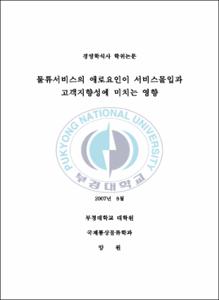물류서비스의 애로요인이 서비스몰입과 고객지향성에 미치는 영향
- Alternative Title
- The Effect of the Logistics Service Difficulties on Service Involvement and Customer Orientation
- Abstract
- After the Korean Freight Union strike, the public began to pay attention to container drivers. Truck freight accounts for 85% of inland container transport in Korea, therefore truck drivers play an important role in inland transport in Korea. If the improvement of transportation circumstances become delayed, unfortunately there will be a deterioration of service involvement and customer orientation. However, according to the literature review, there are few studies on truck drivers and no studies on truck drivers' difficulties, service involvement and customer orientation.
The objectives of this research are as follows:
First, it intends to verify the relationship of logistics service's difficulties, service involvement and customer orientation.
Second, it intends to present the suggestions of promoting truck drivers' service involvement and customer orientation in order to improve logistics companies' performance.
The results of this study can be summarized as follows:
First, it turned out that structural problems and other special conditions have significant negative (-) influences on the service value. Cost problem and colleague conflict have significant positive (+) influences on the service value. The hypothesis about the relationship between the difficulty factor and service value is supported partially.
Second, it turned out that structural problems have significant positive (+) influences on job involvement and customer consideration. Special conditions have significant negative (-) influences on job involvement and customer consideration. The hypothesis about the relationship between difficulty factors, job involvement and customer consideration is supported partially.
Third, it turned out that structural problems have significant positive (+) influences on the individual customer relationship. The hypothesis about the relationship between difficulty factors and individual customer relationships however is supported.
The implication of this study can be summarized as follows:
Firstly, structural problems, such as the gap between supply and demand, the price of increase oil and the overloading supervision and freight rate system are the most important factor.
Secondly, there are service values which drivers perceive as extremely low, on the other hand, they get comparatively strong involvement in their job. It's very important to improve the drivers' conditions in logistics companies, so drivers can realize the significance of job involvement.
Thirdly, to solve the problems of container drivers' service involvement and customer orientation, we must pay attention to the underlying structural problems.
Finally, the problems of container drivers' service involvement and customer orientation should be solved by the government. It is necessary that the government takes constructive measures to support their drivers.
- Issued Date
- 2007
- Awarded Date
- 2007. 8
- Type
- Dissertation
- Keyword
- 물류서비스 애로요인 서비스몰입 고객지향성 Logistics Service
- Publisher
- 부경대학교 대학원
- Alternative Author(s)
- Yang, Yuan
- Affiliation
- 부경대학교 대학원
- Department
- 대학원 국제통상물류학과
- Advisor
- 조찬혁
- Table Of Contents
- 제 1 장 서론 = 1
제 1 절 연구의 배경 및 목적 = 1
제 2 절 연구의 범위 및 방법 = 2
제 3 절 논문의 구성 = 2
제 2 장 이론적 배경 = 4
제 1 절 애로요인 = 4
1. 구조문제 = 4
2. 비용문제 = 6
3. 지시문제 = 7
4. 특수상황 = 8
5. 동료문제 = 8
제 2 절 서비스몰입 = 10
1. 서비스몰입 = 10
2. 서비스가치 = 11
3. 직무몰입 = 13
제 3 절 고객지향성 = 16
제 3 장 연구모형 및 가설설정 = 19
제 1 절 연구모형 = 19
제 2 절 연구가설의 설정 = 20
제 3 절 변수의 조작적 정의 = 20
1. 애로요인 = 20
2. 서비스몰입(Service Involvement) = 21
3. 고객지향성(Customer Orientation) = 21
제 4 절 표본선정 및 설문지 구성결과 분석 = 22
1. 표본선정 = 22
2. 설문지 구성 = 22
제 4 장 가설검증 및 분석결과 = 24
제 1 절 자료의 분석 = 24
1. 설문 응답 기사의 일반 현황 = 24
2. 표본 및 자료의 측정 방법 = 26
3. 응답자료의 일반현황 = 27
4. 응답집단별 특성 = 33
제 2 절 실증분석의 결과 = 40
1. 신뢰성 검증 = 40
2. 타당성 검증 = 44
3. 상관관계 분석 = 46
4. 가설검증 = 48
5. 실증분석 결과해석 = 57
제 5 장 결론 = 60
제 1 절 연구결과의 의미 = 60
1. 연구결과의 요약 = 60
2. 연구결과의 시사점 = 61
제 2 절 연구의 한계 및 향후 연구과제 = 62
참고문헌 = 64
설문지 = 70
감사의 글 = 75
- Degree
- Master
- Appears in Collections:
- 대학원 > 국제통상물류학과-FTA비즈니스전공
- Files in This Item:
-
-
Download
 물류서비스의 애로요인이 서비스몰입과 고객지향성에 미치는 영향.pdf
기타 데이터 / 1.49 MB / Adobe PDF
물류서비스의 애로요인이 서비스몰입과 고객지향성에 미치는 영향.pdf
기타 데이터 / 1.49 MB / Adobe PDF
-
Items in Repository are protected by copyright, with all rights reserved, unless otherwise indicated.